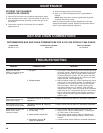
11
UK
■■
■■
■ Maintain a proper grip on the saw whenever the engine is
running. The fingers should encircle the handle and the
thumb be wrapped under the handlebar. This grip is least
likely to be broken (by a kick-back or other sudden reaction
of the saw). Any grip in which the thumb and fingers are on
the same side of the handle is dangerous because a slight
kick of the saw can cause loss of control.
WARNING:
DO NOT operate the throttle trigger with your left hand
and hold the front handle with your right hand. Never
allow any part of your body to be in the chain line while
operating a saw.
CHAIN LINE
PUSH AND PULL
See Figure 19.
The reaction force is always opposite to the direction the chain
is moving. Thus, the operator must be ready to control the PULL
(A) when cutting on the bottom edge of the bar and the PUSH
(B) when cutting along the top edge.
NOTE: Your chainsaw has been fully factory tested. It is normal to
find some slight oil residue on the saw.
PROPER CUTTING STANCE
See Figure 20.
■■
■■
■ Balance your weight with both feet on solid ground.
■■
■■
■ Keep left arm with elbow locked in a “straight arm” position
(B) to withstand any kick-back force.
■■
■■
■ Keep your body to the left of the chain line (A).
■■
■■
■ Keep your thumb on underside of handlebar (C).
BASIC OPERATING/CUTTING PROCEDURES
Practise cutting a few small logs using the following technique
to get the “feel” of using your saw before you begin a major
sawing operation.
1. Take the proper stance in front of the wood with the
saw idling.
2. Accelerate the engine to full throttle just before entering the
cut by squeezing the throttle trigger.
3. Begin cutting with the saw against the log.
4. Keep the engine at full throttle the entire time you are cutting.
5. Allow the chain to cut for you; exert only light downward
pressure. Forcing the cut could result in damage to the bar,
chain, or engine.
6. Release the throttle trigger as soon as the cut is completed
allowing the engine to idle. Running the saw at full throttle
without a cutting load can result in unnecessary wear to the
chain, bar, and engine.
7. Do not put pressure on the saw at the end of the cut.
WORK AREA PRECAUTIONS
See Figure 21.
■■
■■
■ Cut only wood or materials made from wood; no sheet metal,
no plastics, no masonry, no non-wood building materials.
■■
■■
■ Never allow children to operate your saw. Allow no person to
use this chainsaw who has not read this operator’s manual
or received adequate instructions for the safe and proper
use of this chainsaw.
■■
■■
■ Keep everyone – helpers, bystanders, children, and animals,
a SAFE DISTANCE from the cutting area. During felling
operations, the safe distance should be a least twice the
height of the largest trees in the felling area. During bucking
operations, keep a minimum distance of (4.5 m) 15 ft.
between workers.
■■
■■
■ Always cut with both feet on solid ground to prevent being
pulled off balance.
■■
■■
■ Do not cut above chest height as a saw held higher is
difficult to control against kick-back forces.
■■
■■
■ Do not fell trees near electrical wires or buildings. Leave this
operation for professionals.
■■
■■
■ Cut only when visibility and light are adequate for you to
see clearly.
ADJUSTING THE CARBURETTOR
See Figures 22, 23, and 24.
Before adjusting the carburettor, clean the air filter (A) and the
starter cover vents (B). Allow the engine to warm up prior to
carburettor adjustment. Refer to “Maintenance” later in this
manual.
The carburettor is factory set and should not require adjusting.
The carburettor will permit only limited adjustment of the “L”
(Low Jet) and “H” (High Jet) needles. Any adjustment should be
done by a Ryobi service dealer.
Under no circumstances should the “L” (Low Jet) and “H”
(High Jet) needles be forced outside the range of adjustment.
CAUTION:
Serious damage can occur to the engine if improper
adjustments are made to the “L” and “H” needles.
Do not force the “L” and “H” needles outside the
adjustment range!
■■
■■
■ Hold the saw firmly with both hands. Always keep your LEFT
HAND on the front handle and your RIGHT HAND on the rear
handle so that your body is to the left of the chain line.
WARNING:
Never use a left-handed (cross-handed) grip or any stance
that would place your body or arm across the chain line.
OPERATION


















